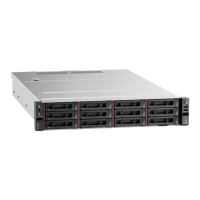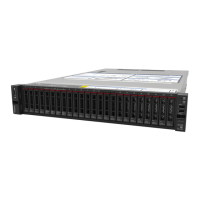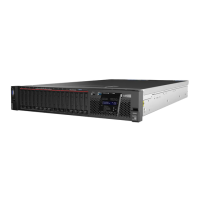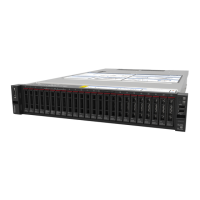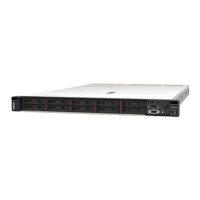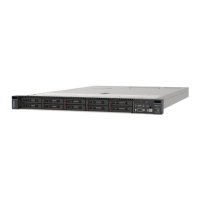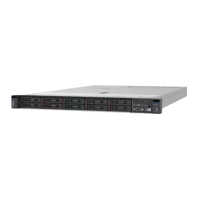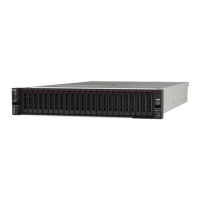Do you have a question about the Lenovo ThinkSystem SR530 and is the answer not in the manual?
Learn how to identify your server using the machine type and serial number for support.
Information about the network access label for the XClarity Controller.
Details on the QR code for mobile access to service information.
Summary of the server's features and technical specifications.
Visual overview of the server's front panel components and drive bays.
Explanation of the controls and LEDs on the operator information panel.
Identification of connectors and components on the server's rear panel.
Description of status LEDs located on the rear panel of the server.
Diagram showing the location of components on the server's system board.
Location and function of switches and jumpers on the system board.
Identification of light-emitting diodes (LEDs) on the server's system board.
Guidelines for connecting and routing internal cables within the server.
Information on cable routing for the video graphic adapter (VGA) connector.
Details on cable routing for the front I/O assembly.
Explanation of cable routing for RAID super capacitor modules.
Internal cable routing for server models with different drive bay configurations.
List and identification of available server components and parts.
Information on available power cords and their specifications.
General guidelines and precautions before installing server components.
Checklist to identify potentially unsafe conditions with the server.
Guidelines to ensure proper system cooling and reliability.
Precautions and procedures for working inside the server while it is powered on.
Guidelines for safely handling static-sensitive components to prevent damage.
Procedures for removing and installing server rack latches.
Steps for removing and installing the server's security bezel.
Instructions for removing and installing the server's top cover.
Procedures for removing and installing the server's air baffle.
Instructions for removing and installing RAID super capacitor modules.
Steps for removing and installing server system fans.
Procedures for removing and installing the server's front I/O assembly.
Instructions for replacing hot-swap drive backplanes for different drive configurations.
Procedures for replacing simple-swap drive backplate assemblies.
Steps for removing and installing hot-swap hard disk drives (HDDs) and SSDs.
Procedures for removing and installing simple-swap hard disk drives (HDDs) and SSDs.
Instructions for removing and installing server memory modules (DIMMs).
Steps for removing and installing the CMOS battery.
Procedures for replacing TCM/TPM adapters, specific to Chinese Mainland.
Instructions for removing and installing hot-swap power supplies.
Steps for removing and installing PCIe adapters in the server.
Procedures for removing and installing riser cards and assemblies.
Instructions for replacing M.2 backplanes and M.2 drives.
Procedures for removing and installing the serial port module.
Steps for removing and installing the LAN on Motherboard (LOM) adapter.
Instructions for replacing processors and heat sinks.
Procedures for removing and installing the server's system board.
Steps to enable UEFI Secure Boot for enhanced system security.
Instructions for updating the server's machine type and serial number after replacement.
Final steps to ensure all components are reassembled correctly after replacement.
Information to resolve issues related to hard disk drives.
Information on how to access and interpret event logs for troubleshooting.
General steps to resolve problems when error logs are unclear or the server is inoperative.
Procedures to troubleshoot and resolve issues with the server's Ethernet controller.
Steps to diagnose and resolve issues related to power supplies and power distribution.
Guide to resolving problems based on identifiable symptoms.
Solutions for issues encountered when powering the server on or off.
Troubleshooting steps for problems related to server memory modules.
Steps to solve problems related to the server's monitor or video output.
Troubleshooting for issues with keyboard, mouse, or USB devices.
Guide to resolving problems related to optional devices.
Solutions for problems related to serial ports or devices.
Guidance for resolving intermittent issues with server operation.
Steps to take before contacting support to resolve issues yourself.
Guidance on self-help troubleshooting using provided documentation.
Information to prepare before contacting Lenovo support for warranty service.
Methods and tools for collecting service data for analysis and support.
List of trademarks used in the document and their owners.
Notes on processor speed, storage units, memory, and solid-state device limitations.
Regulatory statement regarding connection to public telecommunications networks.
Notices related to electronic emissions and monitor cable usage.
RoHS declaration specific to Taiwan's BSMI standards.
Contact information for Taiwan import and export inquiries.
Learn how to identify your server using the machine type and serial number for support.
Information about the network access label for the XClarity Controller.
Details on the QR code for mobile access to service information.
Summary of the server's features and technical specifications.
Visual overview of the server's front panel components and drive bays.
Explanation of the controls and LEDs on the operator information panel.
Identification of connectors and components on the server's rear panel.
Description of status LEDs located on the rear panel of the server.
Diagram showing the location of components on the server's system board.
Location and function of switches and jumpers on the system board.
Identification of light-emitting diodes (LEDs) on the server's system board.
Guidelines for connecting and routing internal cables within the server.
Information on cable routing for the video graphic adapter (VGA) connector.
Details on cable routing for the front I/O assembly.
Explanation of cable routing for RAID super capacitor modules.
Internal cable routing for server models with different drive bay configurations.
List and identification of available server components and parts.
Information on available power cords and their specifications.
General guidelines and precautions before installing server components.
Checklist to identify potentially unsafe conditions with the server.
Guidelines to ensure proper system cooling and reliability.
Precautions and procedures for working inside the server while it is powered on.
Guidelines for safely handling static-sensitive components to prevent damage.
Procedures for removing and installing server rack latches.
Steps for removing and installing the server's security bezel.
Instructions for removing and installing the server's top cover.
Procedures for removing and installing the server's air baffle.
Instructions for removing and installing RAID super capacitor modules.
Steps for removing and installing server system fans.
Procedures for removing and installing the server's front I/O assembly.
Instructions for replacing hot-swap drive backplanes for different drive configurations.
Procedures for replacing simple-swap drive backplate assemblies.
Steps for removing and installing hot-swap hard disk drives (HDDs) and SSDs.
Procedures for removing and installing simple-swap hard disk drives (HDDs) and SSDs.
Instructions for removing and installing server memory modules (DIMMs).
Steps for removing and installing the CMOS battery.
Procedures for replacing TCM/TPM adapters, specific to Chinese Mainland.
Instructions for removing and installing hot-swap power supplies.
Steps for removing and installing PCIe adapters in the server.
Procedures for removing and installing riser cards and assemblies.
Instructions for replacing M.2 backplanes and M.2 drives.
Procedures for removing and installing the serial port module.
Steps for removing and installing the LAN on Motherboard (LOM) adapter.
Instructions for replacing processors and heat sinks.
Procedures for removing and installing the server's system board.
Steps to enable UEFI Secure Boot for enhanced system security.
Instructions for updating the server's machine type and serial number after replacement.
Final steps to ensure all components are reassembled correctly after replacement.
Information to resolve issues related to hard disk drives.
Information on how to access and interpret event logs for troubleshooting.
General steps to resolve problems when error logs are unclear or the server is inoperative.
Procedures to troubleshoot and resolve issues with the server's Ethernet controller.
Steps to diagnose and resolve issues related to power supplies and power distribution.
Guide to resolving problems based on identifiable symptoms.
Solutions for issues encountered when powering the server on or off.
Troubleshooting steps for problems related to server memory modules.
Steps to solve problems related to the server's monitor or video output.
Troubleshooting for issues with keyboard, mouse, or USB devices.
Guide to resolving problems related to optional devices.
Solutions for problems related to serial ports or devices.
Guidance for resolving intermittent issues with server operation.
Steps to take before contacting support to resolve issues yourself.
Guidance on self-help troubleshooting using provided documentation.
Information to prepare before contacting Lenovo support for warranty service.
Methods and tools for collecting service data for analysis and support.
List of trademarks used in the document and their owners.
Notes on processor speed, storage units, memory, and solid-state device limitations.
Regulatory statement regarding connection to public telecommunications networks.
Notices related to electronic emissions and monitor cable usage.
RoHS declaration specific to Taiwan's BSMI standards.
Contact information for Taiwan import and export inquiries.
| Tcase | 77 °C |
|---|---|
| Stepping | U0 |
| Scalability | 2S |
| Processor code | SR3GJ |
| Processor cache | 11 MB |
| Processor cores | 8 |
| Processor model | 4108 |
| System bus rate | - GT/s |
| Processor socket | LGA 3647 (Socket P) |
| Processor threads | 16 |
| Processor codename | Skylake |
| Execute Disable Bit | Yes |
| Number of QPI links | 2 |
| Processor frequency | 1.8 GHz |
| Processor cache type | L3 |
| Processor lithography | 14 nm |
| Processor manufacturer | Intel |
| Processor package size | 76.0 x 56.5 mm |
| Processor boost frequency | 3 GHz |
| Processor operating modes | 64-bit |
| Embedded options available | No |
| Supported instruction sets | AVX, AVX 2.0, AVX-512, SSE4.2 |
| Thermal Design Power (TDP) | 85 W |
| Number of processors installed | 1 |
| Maximum number of PCI Express lanes | 48 |
| Memory types supported by processor | DDR4-SDRAM |
| Memory channels supported by processor | Hepta |
| Memory clock speeds supported by processor | 2400 MHz |
| Maximum internal memory supported by processor | 768 GB |
| Memory slots | 24x DIMM |
| Internal memory | 16 GB |
| Memory clock speed | 2666 MHz |
| Maximum internal memory | 3072 GB |
| Memory layout (slots x size) | 1 x 16 GB |
| Power supply | 750 W |
| Power supply input frequency | 50 - 60 Hz |
| HDD size | - \ |
| RAID levels | 0, 1, 5, 6, 10, 50, 60, JBOD |
| Supported HDD sizes | 2.5 \ |
| Total storage capacity | 0 GB |
| Maximum storage capacity | 61.4 TB |
| Number of HDDs installed | - |
| Supported RAID controllers | 530-8i |
| Supported storage drive interfaces | SAS, Serial ATA III |
| Cabling technology | 10/100/1000Base-T(X) |
| USB 2.0 ports quantity | USB 2.0 ports have a data transmission speed of 480 Mbps, and are backwards compatible with USB 1.1 ports. You can connect all kinds of peripheral devices to them. |
| PCI Express slots version | 3.0 |
| Chassis type | Rack (1U) |
| Performance management | XClarity Standard |
| Trusted Platform Module (TPM) version | 1.2 |
| Operating altitude | 0 - 3048 m |
| Storage temperature (T-T) | -10 - 60 °C |
| Operating temperature (T-T) | 5 - 45 °C |
| Operating relative humidity (H-H) | 8 - 90 % |
| Sustainability certificates | ENERGY STAR |
| Processor ARK ID | 123544 |
| Intel TSX-NI version | 1.00 |
| Depth | 778.3 mm |
|---|---|
| Width | 482 mm |
| Height | 43 mm |

